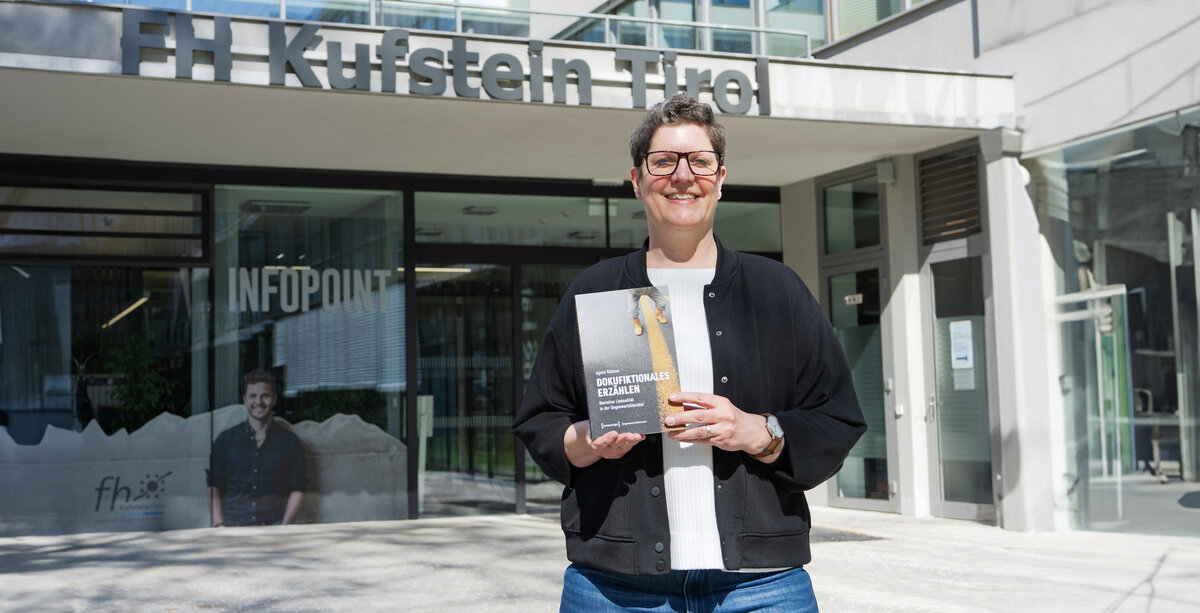Truth or fiction? New book by Agnes Bidmon
- 15.05.2025
- General

Prof. (FH) PD Dr. Agnes Bidmon with her new book Docu-fictional Narrative.
What is real and what is fiction? In times of fake news, AI content, and the desire for authenticity, this question is becoming increasingly urgent and the boundaries are becoming increasingly blurred. In her new book, Prof. (FH) PD Dr. Agnes Bidmon explores docufiction—a borderland between reality and invention.
Docufiction – Narrative Liminality in Contemporary Literature is the title of the book that hit stores in mid-March. In recent years, the term docu-fiction has become a real success label in film, television, and literature. However, it often remains unclear what exactly it means. This is precisely where Agnes Bidmon, professor of cultural management and cultural studies in the Sports, Culture, and Event Management degree program at the University of Applied Sciences Kufstein Tirol, comes in – with the aim of systematically defining docu-fiction narrative for the first time.
A PHENOMENON OF OUR TIME
In conversation with the cultural scientist, it becomes clear that the examination of docu-fictional narrative strategies is not merely an academic exercise. Rather, it is rooted in social upheavals and cultural changes that have rapidly gained momentum since the mid-2010s. The Brexit campaign, the 2016 US presidential election, debates about fake news, and the increasing prevalence of deepfakes have all contributed to the question of how it is even possible to distinguish between fact and fiction in narratives, both literary and audiovisual.
OBJECTIVITY IS A MYTH.
Agnes Bidmon
Professor (FH) of Cultural Management & Cultural Studies
In the interview, Bidmon refers to poststructuralist and postmodern theories that have long since questioned the idea of objective truth. Instead, he argues that it is important to analyze the mechanisms and narrative strategies used by media content to claim authenticity—and how we as recipients respond to this.
NOT A GENRE, BUT A STORYTELLING STYLE
A central thesis of the book is that docufiction is not a separate literary or cinematic genre, but rather a specific narrative technique. It can appear in very different media and employs strategies drawn from both fictional and factual repertoires. From mockumentaries and hybrid texts with inserted photos to literary montages made from transcripts and archive material, the forms of expression are diverse and the transitions fluid.
What is particularly exciting, as Bidmon explains, is that it is not just about deliberately mixing fact and fiction, but also about the way in which it is presented. For example, if a text looks like a court transcript, is written in old-fashioned typewriter font, and names are blacked out, the audience gets the impression that it is an authentic document—even if everything is fictitious. “Writing is an ontologically indifferent medium,” explains Bidmon. “It always looks the same, regardless of whether what it conveys is true or not.”
BETWEEN ENLIGHTENMENT AND SEDUCTION
Precisely for this reason, Bidmon also sees an ethical responsibility in dealing with docufiction. When literature, films, or series take up historical events or biographies, it must be clear that a complete, objective representation is hardly possible—and that interpretations, gaps, and narrative breaks are part of the narrative. This can have both an enlightening and a deceptive effect, depending on the objective of the work and whether the narrative seeks to establish a different truth or to undermine a supposedly known one.
According to Bidmon, literature is particularly sensitive when it comes to the Shoah or the Holocaust. In this context, she explains, there is a clear moral boundary in German-speaking countries: alienation, playful fictionalization, or even kitsch are considered inappropriate by many. The debates surrounding controversial works such as Stella by Takis Würger underscore this.
What the audience believes is up to him
The role reversal of the audience is also exciting: ultimately, it is the audience itself that decides how credible a story appears. Depending on media literacy, prior experience, and expectations, a docufiction text can be interpreted in completely different ways. The fact that the audience is often overwhelmed by this responsibility is particularly evident when popular productions such as Bohemian Rhapsody or The Crown are perceived as almost documentary, even though they contain clear fictional elements.
For Bidmon, the challenge of the future therefore lies in strengthening ambiguity tolerance: the ability to tolerate ambiguity, recognize contradictions, and form a differentiated judgment—especially in an age when information flows are becoming increasingly complex and manipulative.
RESEARCH THAT CAPTURES THE SPIRIT OF THE TIMES
With Dokufiktionales Erzählen, Agnes Bidmon not only delivers a well-founded academic work, but also a highly topical plea for more reflection in our dealings with media and narratives.
She analyzes a cultural phenomenon that has long been part of our everyday lives—from Instagram filters to Netflix biopics. And she does so with impressive methodological depth that will appeal to literary scholars as well as those interested in culture and media.
Links:
- Docufiction – Narrative Liminality in Contemporary Literature | transcript Verlag - can be ordered here
- Sports, Culture & Event Management | ft
